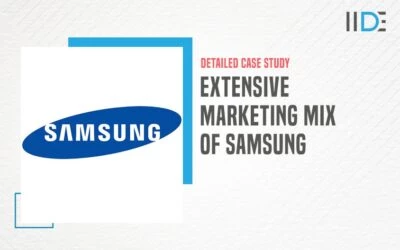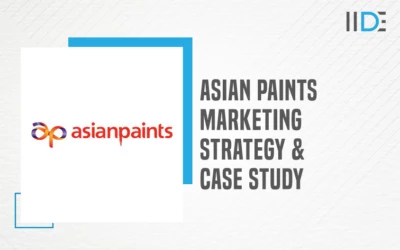Intel is an American multinational technology company that develops, manufactures, and sells computer hardware and software. Ever since its inception, Intel has been monumental in building state-of-the-art IT infrastructure not only for its own services but also for the entire industry. Today, Intel has more than 100 locations around the globe.
In this case study, we will be talking about the marketing strategies of Intel with the help of its marketing mix, marketing campaigns, SWOT analysis, and digital marketing presence. So let’s get right into it by first getting to know the company a little better.
About Intel

Intel is headquartered in Santa Clara, California. The company was founded on July 18, 1968, by Robert Noyce and Gordon Moore. It is the world’s largest semiconductor chip manufacturer and developer of microprocessors. The company also manufactures graphic chips, network interface controllers and integrated circuits, motherboard chipsets, flash memory, embedded processors, and other equipment related to computing.
Basically, Intel provides computers, networking, data storage, and communications platforms. A lesser-known fact about the company is that the name ‘Intel’ was conceived from the words ‘integrated’ and ‘electronics’.
The company is presently divided into the following segments:
- The Client Computing Group (CCG)
- The Data Center Group (DCG)
- The Internet of Things Group (IOTG)
- The Non-Volatile Memory Solutions Group (NSG)
- The Programmable Solutions Group (PSG)
- and All Other.
Now that we understand the company’s business and history, let’s start discussing its marketing beginning with the marketing strategies including marketing mix.
Current News about the brand
- Intel Beats AMD And NVIDIA To Releasing GPU Drivers Optimized For Baldur’s Gate 3: Intel has released new graphics drivers that are optimized for the upcoming role-playing game Baldur’s Gate 3, which is expected to launch on October 6.
- Intel claims that its drivers will improve the performance and stability of the game on its Arc A7 GPUs, which are its upcoming gaming graphics cards.
- Intel also says that its drivers will support other popular games such as Deathloop, Far Cry 6, and Marvel’s Guardians of the Galaxy.
- Microsoft Surface Pro 9 specs leaked (Intel and Qualcomm… – Liliputing: Microsoft is expected to launch its new Surface Pro 9 tablet later this year, and some of its specifications have been leaked online.
- According to Liliputing, the Surface Pro 9 will come in two versions: one with an Intel Core i7-1185G7 processor and another with a Qualcomm Snapdragon SC8180XP processor. Both versions will have 13-inch displays with a resolution of 2880 x 1920 pixels, 8GB or 16GB of RAM, and 128GB or 256GB of storage.
Targeting Audience
Targeting the audience of Intel typically involves addressing individuals and organizations with an interest in technology, particularly those related to computing, semiconductors, and innovation. Intel’s audience can be quite diverse, ranging from professionals in the tech industry to consumers interested in the latest advancements.
It includes software developers, hardware engineers, data scientists, and IT professionals who use Intel’s products and technologies to create and maintain cutting-edge solutions.
When targeting Intel’s audience, it’s important to consider the specific needs, pain points, and interests of each segment. Tailor your messaging and content to address their concerns and showcase how Intel’s products and technologies can provide solutions. This could involve creating informative articles, blog posts, videos, webinars, whitepapers, and other content that demonstrates the value of Intel’s offerings in various contexts. Additionally, leveraging social media, tech forums, industry events, and partnerships can help you effectively reach and engage with Intel’s diverse audience.

Buyer’s Persona
Name:
Rajesh Sharma
Place:
Bangalore, India
Age:
40 years
Profession:
IT Manager
Motivation
- Quality.
- Innovation.
- Performance & Speed.
- Security.
Interest & Hobbies
- Technology.
- Education.
- Sports
- Movies
- Music
Pain Points
- Losing his Jobs
- Falling behind in technology
- Getting hacked or attacked by cybercriminals
- Wasting time & money
Social Media Presence
- Tinder
- Youtube
- Quora
Marketing Strategies of Intel
In this section of the blog, we shall discuss Intel’s marketing strategies by way of its STP i.e. segmentation, targeting, and positioning. Intel narrows down the large and varied target audience into specific groups, from heterogeneous to homogeneous groups to understand the buying behaviors of customers. Intel, thus, carries out its segmentation based on demographic factors- based on age, life cycle, gender, income, religion, race, and nationality as well as psychographic factors- based on consumer buying behavior, such as lifestyle, values, attitudes, interests, etc.
An undifferentiated targeting strategy is used by Intel to target these segments as most of its products are standardized and available worldwide. Intel’s target audience is anyone and everyone searching for a new computer. Intel is known mainly for its processors and chips, and so the company positions its products and services based on the product’s usage and benefits.
Primarily, focusing on their value as a brand in their positioning. From this positioning of ‘High-Quality Technology Products’, Intel recently repositioned itself as a ‘Leader in Technology Breakthroughs.’ This positioning is well-strategized when looking at its history and contributions to the industry.
Moving further, another major part of a company’s marketing efforts is its campaigns. Let’s take a look at some of Intel’s marketing campaigns.
Intel’s Marketing Campaigns
Intel has successfully carried out various marketing campaigns over its many years of existence in the industry. These campaigns not only help promote its products but also set the tone for the brand in the minds of the consumers. Following are two of Intel’s most memorable marketing campaigns:
-
“The Sponsors of Tomorrow”

The Sponsors of Tomorrow was the name of one of Intel’s most popular marketing campaigns. So what message did the organization want to communicate with this campaign? Since Intel’s products are designed to serve as a “human” assistant to its clients, the commercial shows an emotional connection with them. The campaign echoes this sentiment as Intel’s advanced level of technology is aimed at shaping the present and future, with the IT giant playing the part of a sponsor. Thus, showing Intel as a sponsor of the futuristic tomorrow. This was a viral campaign and got Intel a lot of brand recognition.
-
“Go Do Something Wonderful”
The “Go Do Something Wonderful” campaign, which is based on a quote from Intel co-founder Robert Noyce, aims to inspire people about what they can do with the aid of a PC with Intel Inside. The ad focuses on stories that demonstrate what all technology can accomplish for each person.
After learning about the company’s many marketing tools and channels, we conducted a SWOT analysis to get a better understanding of its position.
Intel’s Digital Marketing Presence
Having a strong digital presence is extremely crucial for any company in today’s times, especially a consumer-focused technologically advanced company like Intel. In this section of the blog, thus, we analyze Intel’s social media presence across some of its most important and active platforms.
- Intel has 1.6M followers on Instagram, 4.8M followers on Twitter, and 37 M likes on Facebook.
- They are very active on these social media platforms and post regularly.
- Their posts are mainly filled with lots of images and information about their upcoming products and services. Detailing their services and new features, additions, etc.
- The company also engages in social issues and awareness. For example, they celebrated Women’s History Month by featuring their female employees making history in the industry.

- They also regularly feature accomplished users who swear by their products and use them daily on their pages, by narrating their stories and experiences.

- Festive marketing is also practiced by the company by wishing their customers on various occasions like Valentine’s Day, New Years’, Christmas, etc.

- Lastly, their content is engaging and interactive with the audience as well. They poet random quizzes and questions to their followers which encourages them to comment and share.

Top 5 Competitors of this brand
- TSMC: It is the world’s largest semiconductor foundry, which manufactures chips for other companies, such as AMD, Qualcomm, and Nvidia. TSMC has surpassed Intel in producing chips using advanced technologies, such as 3-nanometer and 5-nanometer processes. TSMC has a revenue of $47.78 billion in 2020, and a market capitalization of $563.54 billion as of October 4, 2021.
- AMD: It is Intel’s main rival in the microprocessor market, especially in the segments of desktops, laptops, and servers. AMD has gained market share and customer loyalty by offering high-performance and low-cost processors, such as Ryzen and Epyc. AMD has a revenue of $9.76 billion in 2020, and a market capitalization of $113.18 billion as of October 4, 2021.
- Nvidia: It is a leader in the graphics processing unit (GPU) market, which is used for gaming, artificial intelligence, cloud computing, and other applications. Nvidia also designs chips for mobile devices, automobiles, and supercomputers. Nvidia has a revenue of $16.68 billion in 2020, and a market capitalization of $543.81 billion as of October 4, 2021.
- Samsung: It is a diversified conglomerate that produces various products and services, such as smartphones, TVs, appliances, memory chips, and displays. Samsung is also a major competitor of Intel in the semiconductor market, as it produces its own processors and memory chips for its devices and other customers. Samsung has a revenue of $197.7 billion in 2020, and a market capitalization of $376.8 billion as of October 4, 2021.
- Qualcomm: It is a leading company in the wireless technology industry, which develops and licenses technologies for mobile devices, such as modems, processors, and chipsets. Qualcomm is also a pioneer in the 5G technology, which is expected to revolutionize the communication and connectivity sectors. Qualcomm has a revenue of $23.53 billion in 2020, and a market capitalization of $173.86 billion as of October 4, 2021.
Example of a Failed Campaign Or Backlash from Viewers
Intel’s ‘Bunny People’ Campaign: This campaign was launched in 1997 to promote Intel’s Pentium II processor. The campaign featured actors dressed in colorful bunny suits, which were inspired by the cleanroom suits worn by Intel’s engineers. The campaign used the slogan ‘It’s what’s inside that counts’ and showed the bunny performing various tasks using computers powered by Intel’s chips. The campaign aimed to create a fun and memorable image for Intel and its products.
- What was the issue?
The campaign faced criticism from some customers and critics who found the bunny people creepy, annoying, or irrelevant. Some customers also complained that the campaign did not explain the features or benefits of Intel’s processor and that it focused too much on the brand name rather than the product value. Some critics also accused Intel of copying Apple’s ‘Think Different’ campaign, which featured famous personalities who used Apple’s products.
- What backlash did the brand face?
The campaign did not achieve its intended results of increasing sales, awareness, or preference for Intel and its products. Instead, the campaign generated negative publicity and backlash for Intel and tarnished its reputation as a serious and innovative technology company. The campaign also failed to differentiate Intel from its competitors, such as AMD, which offered cheaper and faster processors.
- What did the brand do in this situation?
Intel discontinued the campaign after a few months and replaced it with a new campaign called ‘Intel Inside’, which focused on highlighting the performance and quality of Intel’s processors. Intel also changed its marketing strategy to target specific segments of customers, such as gamers, professionals, and enthusiasts, rather than mass audiences.
Conclusion
Intel is one of the largest chipmaker companies and IT equipment manufacturers. The company clearly does justice to its history and brand name with its marketing. Their campaigns have always connected with the audience leading to its massive brand recall today. The marketing mix, especially showed us how each of the marketing strategies and development is well planned and executed to deliver to the customers and retain them effectively.
The marketing strategies of Intel, including its digital marketing presence, have successfully evolved over the years and are up with the times. If Intel continues to innovate in its signature methods, the company shall surely be able to maintain its upward trajectory for even longer. If you want to have a look at the case study of the Asos brand, here you go.
Thank you for reading this blog. We hope our case study was insightful to you and helped you in finding the information you were looking for. If it did, kindly like, share, comment, and let us know!







Exploring the inner workings of business model of Zara,can anyone please provide insights on its unique approach to fashion retailing?
As someone interested in Intel’s marketing strategy, I’m curious if there are any insights on their future campaigns 🤔